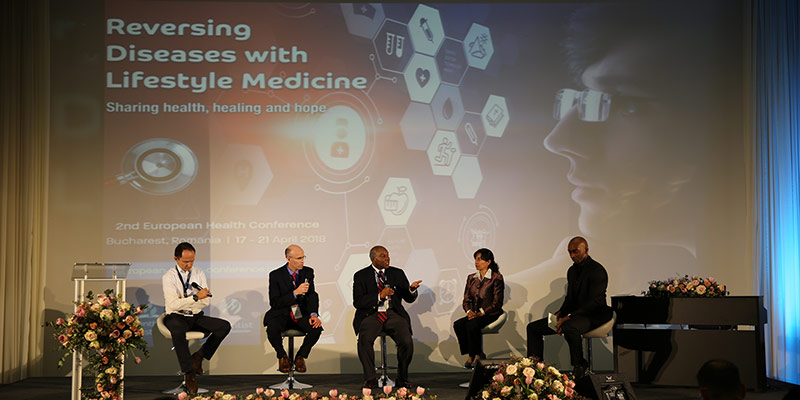Dr Zeno L. Charles-Marcel is an associate director in the Department of Health for the General Conference of the Seventh-day Adventist Church.
He specialises in internal medicine and geriatric medicine, and was dean of the Faculty of Health Sciences at the University of Montemorelos in Mexico. He held the position of Executive Director of the Adventist Missionary Hospital “La Carlota”, as well as Vice President for Medical Relations at Wildwood Hospital and Lifestyle Center. He also served as editor-in-chief of the academic journal Health and Healing published at Wildwood. Currently, Dr Zeno has several teaching commitments at the universities of Montemorelos, Loma Linda, and Andrews, and, until this year, he was an adjunct research professor at the University of Colorado. One of the achievements that Dr Zeno (as his colleagues call him) can be proud of is the fact that he co-founded, with Dr David DeRose, the first American academic fellowship program in the field of lifestyle medicine.
I had the opportunity to listen to Dr Zeno during the European Health Conference and I invited him to explain to our readers what place lifestyle medicine occupies today among medical specialties.
ST: How would you define, in simple words, what “lifestyle medicine” is?
Dr Zeno Charles-Marcel: What we call “lifestyle medicine” describes the use of our daily habits in such a way that they become therapeutic. The point is that some of our habits are positive for our health, while others have a negative impact on our health. Lifestyle medicine aims to strengthen positive habits and change negative habits to positive habits.
Today we are bombarded from all directions with so-called contradictory lifestyle rules. Does the same happen in lifestyle medicine? Can we identify a specific goal of this type of medicine, or is it somehow culturally influenced?
In reality, both observations are valid. Lifestyle medicine has objective characteristics, but it also has culturally influenced characteristics, the latter having more to do with people’s willingness to accept a change in their lifestyle. Take diet as an example. Everyone eats to live. But there are many ways to feed ourselves optimally and they can all be adapted to culture. They actually must be adapted to culture, because otherwise people would not try them.
Moreover, this optimal diet must be easily accessible in the region where we are. We do not expect Europeans to adopt a diet based on the consumption of raw breadfruit[1] (lat., Artocarpus altilis), because the breadfruit is not cultivated here and most people don’t even know what it is. But if I went to a tropical country and mentioned breadfruit, people would immediately know what I mean.
You referred to nutrition as part of lifestyle. However, this is a controversial area even among those who share the same cultural space. If we asked two Europeans what the healthiest way to eat is, we would most likely get two very different answers.
As you mentioned before, we live in the age of information, we have the internet and all the information that is available with its help. Unfortunately, not all information circulating on the internet is correct or confirmed, and yet people use it anyway, indiscriminately.
What I have noticed is that most people, on a superficial analysis of things, will choose those things that are compatible with their previous beliefs. If it is a cultural belief, they will seek to align new habits with old beliefs. When they discover things that are challenging to them, that are different from what they previously believed, or from what they see in the surrounding culture, then it may be harder for them to make a decision against the current. So yes, lifestyle medicine sometimes goes against the flow, and that makes it more challenging, but not impossible, because people around the globe are adopting it.
The question then is: What is optimal for someone? If we are to be genuinely concerned with the individual—the person who will go through a lifestyle change to an optimal style—we must take into account the particularities of that person. In other words, we must take all possible steps to make this transformation an easy task for the patient, one that is as simple as possible.
Therefore, cultural habits that are optimal must, of course, be included. Those habits that are sub-optimal will instead become reasons to advise that person about the alternatives they can use.
We start from the following principle: we do not tell people what not to do until we show them a solid and viable alternative. When we follow this principle, people do much better than if we tell them: ‘Don’t do this or that’, and then let them ask themselves: ‘How do I do best?’ Because when we do not reach an answer, we tend to return to whatever we did before. And when we give up, we quickly come to the conclusion that these things don’t work.
However, before this change-oriented relationship takes place, there is that intermediate stage in which the person chooses, from all the specialists, to turn to you, the doctor who specialises in changing lifestyles. In the context in which (as you mentioned in the presentation you gave at EHC), until recently, lifestyle medicine was viewed with scepticism, how do you build a bridge over this gap that is created, and how you get to the stage where you are face-to-face with the patient?
There are two approaches used in the social promotion of lifestyle medicine. The first is to seek to have as many specialists in lifestyle medicine as possible. I mean to have as many doctors as possible who specialize exclusively in this discipline. My opinion is that this is not the model of action that will bear the most fruit. Let me tell you why. Most people nowadays do not consider lifestyle medicine a medical specialty. So who will look for that specialist? Then, most people are not willing to pay to prevent a disease that they do not think they will have anyway. And last but not least, if the patient is not willing to pay and the health insurance does not cover prevention, how will the patient get to a specialist?
That is why, first of all, I believe that a reform of the insurance system should take place, following which the insurance companies and the government should recognise the specialists in lifestyle medicine, and the services provided by them to be able to be paid by any of the measures provided in the local legislation. Because, if this does not happen, it will be even more difficult for someone to go to a doctor who specialises in lifestyle medicine.
The approach that I think will bear the most fruit is much more fundamental than the first one. During the training of doctors and health workers, they should be taught that changing lifestyle habits is as powerful as medication and surgery—and this is a proven fact—and that this change is part of the medical arsenal we can use to help our patients.
If, in the training of doctors, this principle is presented as a reasonable alternative, in the context of the treatment already implemented, then every doctor would become a lifestyle medicine practitioner to the same extent that today doctors are followers of the pharmacological method. Today, if you go to the doctor and he prescribes you medicine, you consider this to be normal. This is what doctors do: they prescribe drugs. But prescribing medication, in the absence of a lifestyle transformation, may not always be the most appropriate recommendation for the patient’s health.
A doctor who prescribes lifestyle changes may tell the patient that there are several options for the specific problem from which he suffers: you can change what you eat and do X, you can increase the frequency of exercise, you can do Y. In other words, you tell him what he could do, you direct him to someone who can guide and help him in this regard, and that could make an amazing difference in the patient’s life. There is no need to charge the patient specifically for this, because you are only giving him an extra chance to the standard treatment, which is already paid for. You advise him to make some lasting change, getting to the root of the problem, instead of using medication alone; this exclusivity is often the wrong approach.
Where is lifestyle medicine today, in terms of reputation? You said that only recently has the scientific community begun to accept the healing recommendations of lifestyle medicine.
The term “lifestyle medicine” was first used only 20 years ago. But the idea of using lifestyle to treat various diseases is much older, even older than the era of Christ. So we are not talking about a new concept, but about a new description of a very old concept. In our church’s past, what we today call lifestyle change is what Ellen White (co-founder of the Adventist Church) called “health reform.” Health care reform was lifestyle medicine, only no one called it that. Work at the famous Western Health Reform Institute, later the Battle Creek Sanatorium, and the first sanatoriums in the United States, along with the few that were overseas, involved treating people on the basis of what we now call the “principles of lifestyle medicine.” From then on, people were helped to exchange those habits that facilitated the disease with better habits that would act against the disease and restore health.
Historically, this is the trajectory we have. What we are witnessing today is the accumulation of more and more scientific support of our activity in this arena. And this has led to an explosion of interest, which is constantly growing. We have lifestyle medicine groups that are growing and growing on every continent. There is a European lifestyle medicine group, an American college of lifestyle medicine, and so on. The number of practitioners increases from year to year, and in the medical scientific literature, there appear more and more articles related to lifestyle medicine, most related to prevention, but also related to the treatment of diseases. If we were to draw a graph representing this in history, it would be an upward curve, because interest is growing scientifically, clinically, and even in terms of public policy.
Governments that have looked at this issue from the perspective of the costs and productivity of people in their communities or countries clearly recognize that any country on this planet will go bankrupt if the current pace of the strictly pharmaceutical, surgical, and high-quality medical approach is maintained, because this is not a solution to the fundamental problem. Lifestyle medicine and the prevention-oriented approach act directly on the root causes.
Lawmakers are interested in both the global economy and local economies, so they are constantly looking for new ways to reduce the costs associated with disease. They may not be so interested in the well-being of individuals, but they are paying attention to the economic well-being of the whole country or community, because they do not want to go bankrupt. They do not want to have to bear the cost of caring for a huge number of patients while no one is working to keep the economy afloat. If, instead of spending money on drugs and spending money on the surgical insurance budget, we would learn to eat better, get enough sleep, get moving, and so on, we would find that these things cost much less than taking medication for the rest of one’s life.
And yet, you said in the presentation at EHC that multifaceted treatments are not yet very popular among doctors. Why? What is holding them back?
It’s a lack of knowledge. These things are not taught in college. In the Faculty of Medicine, preventive medicine is passed very quickly and, certainly, lifestyle is not talked about as having therapeutic applicability.
And yet, if we look at every professional organisation involved in the treatment of patients with diabetes, for example, at the top of the list of recommendations related to diabetes is written: “Prevention is more desirable than treatment.” Then, if you end up treating it, the first thing on the list of recommendations is to change your lifestyle. If we look at the guidelines of any organisation that deals with the treatment of patients with hypertension, no matter what country these organisations are from, the first on the list of recommendations is a change in lifestyle.
Everywhere, the first recommendation is to transform the lifestyle. The problem is that, in the formative years of the training of health professionals, there is no talk of how to make this change. So doctors move on to the next step: medication.
The subject in medical schools—and what I am about to say may seem controversial to some, but I invite any doctor to contradict me—the subject in college is focused on pharmacology. It is said that the central point is physiology, but even physiology is taught with an eye to pharmacology. Physiology is taught to prepare the student to identify the area where drugs might have an effect.
Why do you think this is?
Because the scientific evidence we have today has been profoundly influenced by the pharmaceutical industry. That’s how we treat things. This is considered standard. And to change the standard you need anticipatory thinking, persistence, and many are not willing to make that effort.
Everything is based on research, and research costs money. Who would be financially interested in materially supporting research in the field of lifestyle medicine? Lifestyle medicine sells nothing. You don’t have any commercial products in the middle. It’s just about what the person does, how they feel, what their perspective on life is. Nothing for sale. In lifestyle medicine, what matters is what the patient does, not what he buys.
Today, however, people tend to be more interested in how they look and feel, and what suits them, what is convenient for them. We were educated to find the pill that would take care of everything. I even heard someone jokingly ask if we didn’t have a pill for a healthy lifestyle. (Laughs) “I’m gonna take this pill and I’ll start eating healthy. I’ll take this other pill and start doing sports.” It is the “quick fix” mentality of instant solutions, as opposed to long-term, radical changes. This preference is something that has been with us throughout history and has not changed.
What has changed is the outward look of lifestyle medicine. For example, in the last 20-25 years we have talked much about what happens to the bacteria in our colon and in our intestines that modulate our health or cause us disease. We do not face new things, we only look at them with new eyes. We have the advantage of being able to look back in history and pray that the things we are talking about will make an impact so that in the future we can look back on our time and see that it was a golden age, when people had the opportunity to make changes that not only prevent, but also cure, a whole range of diseases.
The real danger is that in this generation, children will have a lower average life expectancy than their parents. It could be the first generation in which the upward trend in life expectancy is reversed. Think about it. While today’s children have access to much more information and much more valuable data than their parents, there is a major discrepancy between the availability of good information and the use of that information to bring about a beneficial transformation in their lives.
Alina Kartman is a senior editor at ST Network and Semnele timpului.


















